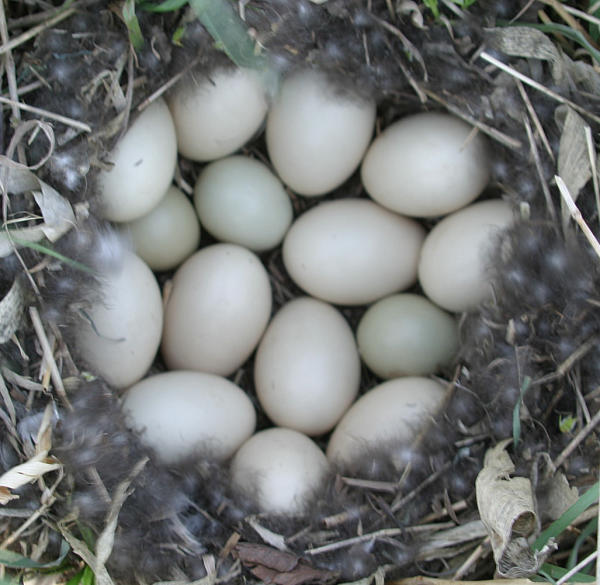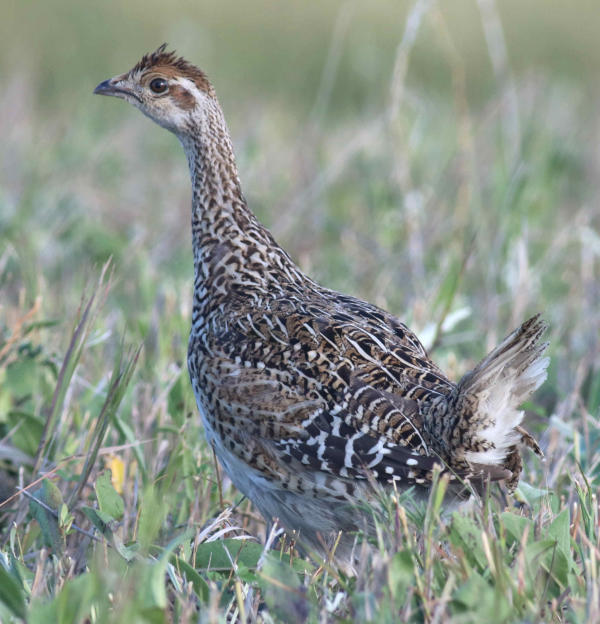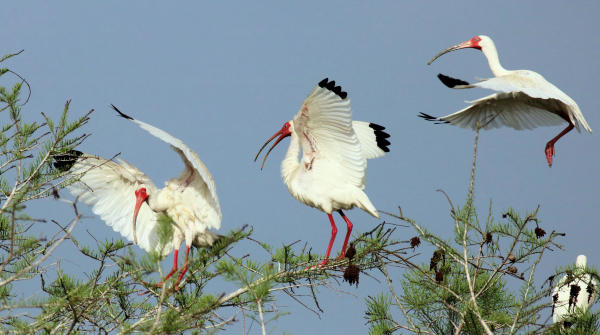Paul started the discussion, recounting that: Tuesday I had a chance to photograph a few individuals of what appeared to be a family flock of Sharp-tailed Grouse, but I was surprised to see a young cock pheasant with them. It made me wonder, was this a chance meeting of the two species, or did a hen pheasant lay one or more eggs in a grouse nest? Ring-necked Pheasant hens are known to lay eggs in the nests of other large ground-nesting birds. In fact, a few years ago I found a Mallard nest that had three pheasant eggs among the clutch she was incubating. Wish I could have seen the look on the face of the downy pheasant hatchlings when the Mallard hen led them to water with their Mallard step-ducklings.

A Mallard nest with a full Mallard clutch plus three smaller Ring-necked Pheasant eggs.
Wednesday, among the daily abundance of waterfowl, wading birds, gulls, swallows and raptors in the area, my rarest find was a relatively close Prairie Falcon slicing through a strong south wind in hunting mode. A Prairie Falcon would usually be the best local sighting almost any other week, but today I was excited to find not one, but two Northern Goshawks!
Two first-fall goshawks together is a first for me, and I was alerted to the first Gos as it turned this way and that in a low pursuit flight of a meadowlark close to my position. I pressed forward a few feet as hunted and hunter dipped into a low area, and that’s when the second immature goshawk took flight from the ground near the location the first Gos originated. This young goshawk provided a clear, relatively close look as it took flight, flew a short distance and landed with its tail and wings spread wide to perch on a post, permitting me to view its overall size and long tail with my 8x binoculars. Definitely an immature Northern Goshawk, as expected for both birds. Next I reached for my camera, but the Gos had already taken flight, looking almost Redtail-sized, and it had a good lead toward a long mature tree grove – end of sighting.
This could be the start of something special, and I hope more goshawks are in my immediate future! While I’m hoping, I also hope to photograph one too. So close today.
Sunday highlights included photographing a female Belted Kingfisher, the first of fall; photographing an immature Northern Harrier hunting on the wing, photographing a young Red-tailed Hawk dispatching a small garter snake while spreading its wings repeatedly in a strong wind. Also, another Sharp-tailed Grouse flock and two broods of Ring-necked Pheasants, and regular flocks of White Pelicans and Franklin’s Gulls, and a few Great Egrets, Great Blue Herons, White-faced Ibis and Greater Yellowlegs.

A young Sharp-tailed Grouse photographed among a family flock.
Wednesday was exciting at my feeding station, when the first bird visited by hot suet feeder, just three days after I first offered it. Who was the first visitor? A female Downy Woodpecker, quickly followed by two Red-breasted Nuthatches (seems a bit early for this species). A Hairy Woodpecker and White-breasted Nuthatch can’t be far behind, I thought. Actually, a White-breasted Nuthatch found the hot sauce Friday, and Saturday a male Downy Woodpecker was another first. The three species have been regular through the weekend.
Peter countered with a fine coastal sunrise story: I had some magical moments with wading birds last week at Huntington Beach State Park on South Carolina’s coast. There is a large wooded swamp where herons, egrets and other species roost at night. Immediately north of the swamp, separated by a dike, is a large freshwater pond; immediately north of that, separated by a causeway, are hundreds of acres of saltwater tidal marshes.
I sat on the causeway at dawn and watched the wading birds pour out of the swamp and either stop in the pond or fly farther north into the saltmarshes to feed. It was an exciting identification challenge, and I used my eBird mobile app to tally in real time what I saw: 210 Great Egrets, 50 Snowy Egrets, 130 Little Blue Herons, 105 Tricolored Herons, 245 small white herons (Snowy Egrets and immature Little Blue Herons were difficult to separate as the flew by in the dawn light), and 275 White Ibis. There were about 140 Wood Storks at the edge of the pond; I suspect they spent the night there.

White Ibis landing in morning light.
A couple Great Herons were present, and both Black-crowned and Yellow-crowned Night Herons were flying in the opposite direction, from the saltmarshes into the swamp where they roost during the day. Single Green Herons departed from the swamp – I counted 13; three Roseate Spoonbills descended into the tidal stream next to me and began feeding. In all, I observed more than 1,100 wading birds as they flew by or were present during a mere 30 minute period!
A couple dozen Caspian Terns hunted continuously over the pond; their screeching calls would be a great soundtrack for the next Jurassic Park film. The sunrise was spectacular as well!
Enjoy your own birding highlights this week!
Photographs by Paul Konrad
Paul Konrad and Peter Stangel are the editors of The Birding Wire; share your sightings or photos at editorstbw2@gmail.com